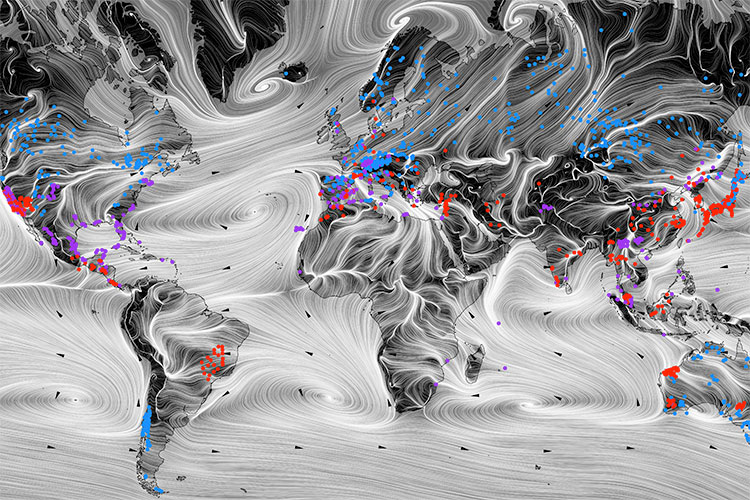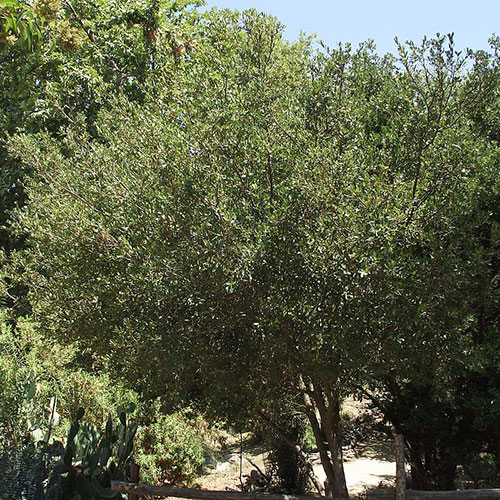As global climate shifts, forests’ futures may be caught in the wind
Global wind currents have shaped the genetic diversity of our planet’s forests and could either help or hinder tree populations in the race to adapt to a changing climate
May 10, 2021

Unlike daily weather, global prevailing wind patterns are believed to be relatively stable over millennial timescales. A new study finds that these wind currents have helped shape genetic diversity in the world’s forests and could impact how well different tree populations are able to adapt to a changing climate. In this image, black arrows and white paths represent global prevailing wind directions, and colored dots represent the locations of the tree populations whose genetic data were analyzed in the study. (UC Berkeley image by Matthew Kling)
Forests’ ability to survive and adapt to the disruptions wrought by climate change may depend, in part, on the eddies and swirls of global wind currents, suggests a new study by researchers at the University of California, Berkeley.
Unlike animals, the trees that make up our planet’s forests can’t uproot and find new terrain if conditions get tough. Instead, many trees produce seeds and pollen that are designed to be carried away by the wind, an adaptation that helps them colonize new territories and maximize how far they can spread their genes.
The new study compared global wind patterns with previously published genetic data of nearly 100 tree and shrub species collected from forests around the world, finding significant correlations between wind speed and direction and genetic diversity throughout our planet’s forests. The findings are the first to show that wind may not only influence the spread of an individual tree or species’ genes, but can also help shape genetic diversity and direct the flow of gene variants across entire forests and landscapes.
Understanding how genetic variants move throughout a species range will become increasingly important as climate change alters the conditions of local habitats, the researchers say.
“How trees move and how plants move, in general, is a big area of uncertainty in plant ecology because it’s hard to study plant movements directly — they happen as a result small, rare movements of seeds and pollen,” said study lead author Matthew Kling, a postdoctoral researcher in integrative biology at UC Berkeley. “However, to predict how species distributions, and plant ecology, in general, will respond to climate change, we need to understand how these species are going to be able to move long distances to track the movement of natural resources and climate conditions over time.”

A model of outbound wind connectivity for wind dispersed seeds originating near Berkeley. Seeds and pollen from the East Bay are expected to be caught in Eastbound winds, fanning out across the Central Valley and into the Sierra foothills (illustrated in yellow and orange). They will be less likely to reach sites along the coast (illustrated in blue and black). (UC Berkeley image by Matthew Kling)
While animals, birds and insects can also disperse pollen and seeds, wind’s strong directionality makes it particularly important for understanding how different tree species will respond to climate change, said study senior author David Ackerly, a professor and dean of UC Berkeley’s Rausser College of Natural Resources.
“As the world warms, many plants and animals will need to move to places with suitable habitat in the future to survive,” Ackerly said. “Wind dispersal has a particularly interesting connection to climate change because wind can either push the genes or organisms in the right direction, toward more suitable habitat, or in the opposite direction. It may be the only terrestrial dispersal vector that can be aligned with or against the direction of climate change.”
Any way the wind blows
Despite the fickle nature of daily weather conditions, large-scale global wind patterns are largely determined by Earth’s shape, rotation and the locations of the continents, and are believed to be relatively stable over millennial timescales. These wind patterns are not likely to be dramatically altered by climate change, Kling said.
To examine whether these global prevailing winds have shaped the genetic diversity of modern-day forests, Kling compared current planetary wind models — compiled from 30 years of global wind data — with genetic data from 72 publications covering 97 tree and shrub species and 1,940 plant populations worldwide.

The island scrub oak Quercus pacifica is native to the Channel Islands in Southern California, where prevailing winds blow to the south and east. Wind dispersal of seeds and pollen contributed to greater genetic diversity of scrub oak populations on southeastern islands. (Public domain photo via Wikimedia commons)
Kling’s analysis revealed three key ways that global wind patterns are shaping forests’ genetic diversity. First, tree populations that are connected by stronger wind currents tend to be more genetically similar than tree populations that are not as connected. Second, tree populations that are more downwind, or farther in the direction that the wind blows, tend to have more genetic diversity in general. Finally, genetic variants are more likely to disperse in the direction of the wind.
Though these patterns can only be statistically validated by looking at many populations of trees throughout the world, they can sometimes be evident when examining the genetic diversity of a single tree species across its habitat range, Kling said.
For example, the island scrub oak, or Quercus pacifica, is native to the Channel Islands in Southern California, where prevailing winds tend to blow to the southeast. Kling’s analysis showed that scrub oak populations on islands that are connected by higher wind speeds are more genetically similar to each other. Genetic variants also appear to have dispersed more frequently to the islands in the southward and eastward directions than the reverse, leading to greater genetic diversity to the south and east.
Kling hopes that recognizing these patterns will help conservationists and ecologists better understand how well tree and plant species in different regions of the globe will adapt to a warming world.
“Populations in different portions of a species range have evolved over time to be well-adapted to the climate in that specific part of the range, and as climate changes, they can become out of sync with those conditions,” Kling said. “Understanding how quickly genetic variants from elsewhere in the species range can get where they are needed is important for understanding how quickly the species will respond to climate change, and how vulnerable, versus resilient, a given population might be.”
This research was supported by a National Science Foundation Graduate Research Fellowship.
RELATED INFORMATION
- Global wind patterns shape genetic differentiation, asymmetric gene flow, and genetic diversity in trees (Proceedings of the National Academy of Sciences)
- Global wind patterns and the vulnerability of wind-dispersed species to climate change (Nature Climate Change)